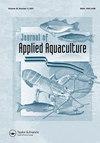Effect of pH, osmolality, Na + and K + on spermatozoa motility of the orange-spotted grouper, Epinephelus coioides
IF 0.8
Q3 FISHERIES
引用次数: 0
Abstract
ABSTRACTThe present study investigated the biosensitivity of Epinephelus coioides spermatozoa under various ionic and osmolality conditions. Activation and sensitivity of sperm started at different pH (7, 7.5, 8, 8.5, and 9) level. The highest motility duration was obtained in pH 8.5 with a significant difference to other groups (P < .001). The E. coioides spermatozoa exposed to 600 mM NaCl solution, 300 mM KCl (in the medium containing 200 mM sucrose), and sucrose solutions with 1100 mosmol/kg osmolality had significantly higher duration of motility than those exposed to solutions with the lower amount of NaCl, KCl and osmolality. Any amount greater than 600 mM NaCl, 300 mM KCl and 1100 mosmol/kg osmolality showed a remarkable reduction in the motility of spermatozoa. Results also showed that the amount of 100 and 450 mM K+, and osmolality lower than 400 mosmol/kg had a significant inhibitory effect and prevented the activity of spermatozoa. The findings of this study showed that changes in K+, Na+ and osmolality of the external solutions affects the spermatozoa and its motility. The potential use of these ions could be applicable for the improvement of the spermatozoa quality of E. coioides during artificial reproduction.KEYWORDS: CationEpinephelus coioidesionssperm motility Disclosure statementNo potential conflict of interest was reported by the authors.Data availability statementThe data that support the findings of this study are available from the corresponding author upon reasonable request.Ethics approval statementAll applicable national and institutional guidelines for the care and use of fish were according to the Iran Veterinary Organization.pH、渗透压、Na +和K +对石斑鱼精子活力的影响
摘要本文研究了卵黄石斑鱼精子在不同离子和渗透压条件下的生物敏感性。精子的激活和敏感性开始于不同的pH(7、7.5、8、8.5和9)水平。pH为8.5时运动时间最长,与其他各组差异有统计学意义(P < 0.001)。600 mM NaCl溶液、300 mM KCl溶液(含200 mM蔗糖)和1100 mosmol/kg渗透浓度的蔗糖溶液处理的精子运动时间显著高于低NaCl、低KCl浓度和低渗透浓度的精子。超过600 mM NaCl、300 mM KCl和1100 mosmol/kg渗透压均显著降低精子活力。结果还表明,100和450 mM的K+浓度以及低于400 mosmol/kg的渗透压均有明显的抑制作用,抑制了精子的活性。本研究结果表明,外液中K+、Na+和渗透压的变化影响精子及其运动。这些离子的潜在用途,可用于提高子囊精在人工繁殖过程中的精子质量。关键词:黄斑石、卵泡、精子活力披露声明作者未报告潜在利益冲突。数据可得性声明支持本研究结果的数据可根据通讯作者的合理要求获得。伦理批准声明所有适用于鱼的护理和使用的国家和机构指南都是根据伊朗兽医组织。
本文章由计算机程序翻译,如有差异,请以英文原文为准。
求助全文
约1分钟内获得全文
求助全文
来源期刊

Journal of Applied Aquaculture
Environmental Science-Ecology
CiteScore
3.20
自引率
0.00%
发文量
38
期刊介绍:
The Journal of Applied Aquaculture is a platform for the sharing of practical information needed by researchers to meet the needs of investors, farm managers, extension agents and policy makers working to adapt aquaculture theory to achieve economic and food security objectives in the real world. The journal emphasizes multi-disciplinary research and case studies that propose financially and logistically viable solutions to observable problems.
 求助内容:
求助内容: 应助结果提醒方式:
应助结果提醒方式:


